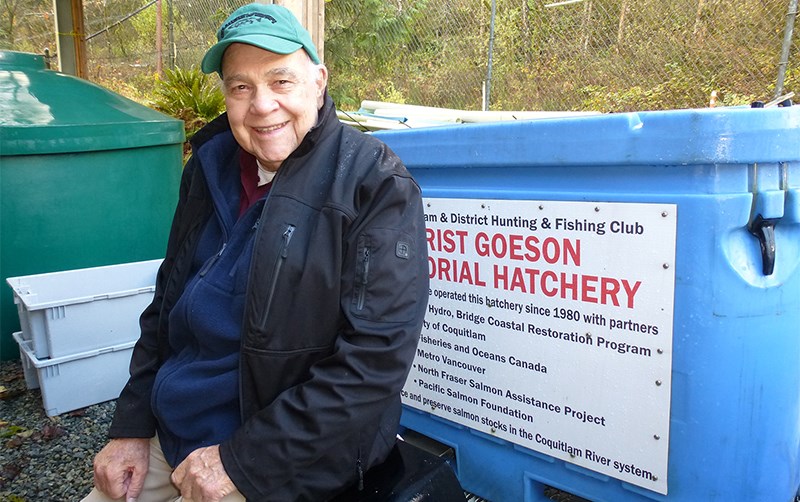On a cold November day when many Tri-City residents will be warming up over a coffee, going to work or getting in some early Christmas shopping, a dozen or more people will be up to their thighs in the frigid, rushing waters of the Coquitlam River. They'll be hauling spawning chinook and coho salmon out of the river by net and, in some cases, fishing rod to get enough males and females to obtain thousands of salmon eggs needed for hatchery operations.
The fall scene is played out in every river and stream in B.C. where hatcheries have been established by Fisheries and Oceans Canada's Salmonid Enhancement Program for the conservation and management of B.C. salmon stocks.
And in Coquitlam, at the Tri-Cities' largest hatchery, it's a ritual that has been taking place for 36 years, resulting in the resurgence of the river's salmon population.
When The Tri-City News visited Grist Goeson Memorial Hatchery on Pipeline Road in Coquitlam, the hatchery volunteers were waiting for tomorrow (Nov. 3), when they can go in the river to catch up to 150 adult coho spawners as well as a number of chinook depending on the size of the run — if there are too few, the hatchery will have to import eggs from chinook caught in the Vedder River in Chilliwack.
The group is hoping to collect 80,000 salmon eggs and will return to the river each Thursday wearing life preservers and hip waders to collect the number allotted them by Fisheries and Oceans Canada.
Now is when the coho return to Coquitlam River, along with chum and chinook, and it will take several days for volunteers to catch enough spawning salmon. To make sure they don't deplete a run and to ensure diversity, they'll head to different areas of the river on different days. The River Springs subdivision, where the river is accessible, is a popular spot.
But it's a risky business, and not for those who don't like to be cold and wet. Volunteers will sometimes fall into the river and the weather is usually bad but everyone gets involved in the task.
"The younger, stronger guys go across," jokes Norm Fletcher, volunteer hatchery co-ordinator, describing how the net is drawn across the river, with volunteers beating rocks with sticks downriver to steer salmon into the trap.
If the water is running too high — above eight metres in depth near the dam is the limit — then the job of catching spawning salmon has to be done from the river bank.
Only the strong and skilled can handle this task because the fish are heavy — a chinook can weigh as much as 25 lb. — and the powerful current makes it difficult to land the salmon safely.
"If you hook a big one, see ya," laughs Mike Jensen, another hatchery volunteer who until recently worked at the Coquitlam water plant just up the road and always keeps his boots and rod in his truck.
"You might have to buy a new line," said Fletcher. "The fish are experts at using the current. That adds considerably to the weight on the line."
Still, the volunteers look forward to the day they will get to work capturing the adult returning salmon with nets, rods, special bags for transporting them, oxygen cylinders and water tanks all ready for the job.
Once the fish are caught, they are stored in tanks until the female's eggs are ready to be released and mixed with the fertilizing milt from spawning male salmon.
The eggs are placed in trays for incubation, with volunteers taking turns to feed the fish once they hatch.
Months later — in April for the chinook fry, the following June for coho — the salmon will be released into the Coquitlam River for their journey out to the ocean.
Hopefully, a good many will return.
Today, though, the Port Coquitlam and District volunteers are keeping their eyes on the river, watching the weather and taking a close look at the fish that have already returned home to continue the cycle of life.
"I love it," Jensen said. "It's nature in action."
BY THE NUMBERS
Recent run sizes in the Coquitlam River
• 3,000 to 4,000 chinook
• 15,000 to 40,000 chum
• 3,000 to 4,000 coho
• 8,000 to 12,000 pink
• 100 to 200 steelhead
• 2 to 6 sockeye
– source: PCDHFC Hatchery operations (pcdhfc.com/hatchery.htm)



